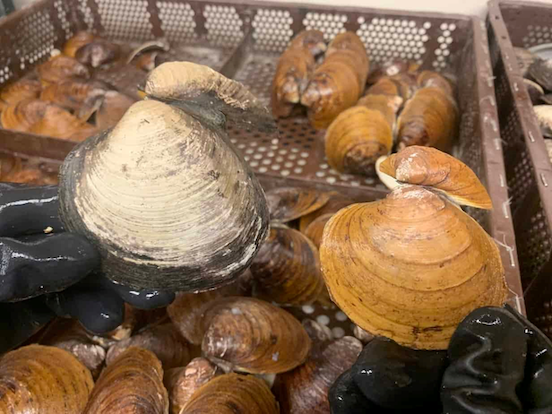Two recently published studies provide a depth of new information on ocean quahog, one of the longest-lived species in the ocean. Along with surf clams, ocean quahogs are the resource for the East Coast sea clam industry, with landings worth $77 million in 2021, according to federal fisheries statistics.
Funded as part of the Science Center for Marine Fisheries' (SCEMFIS) ongoing work on the species, the studies provide extensive new data on ocean quahog age, length, natural mortality, recruitment patterns, and other key population dynamics that are crucial to fisheries managers.
While ocean quahog is a sustainably managed fishery, there is much that fisheries managers do not know about the species; getting a clearer picture of these metrics will give regulators additional tools to improve quahog management. To do this, the studies, which were both published in the journal Marine Biology, examine ocean quahog samples that were previously collected at sites off the coast of Long Island, New Jersey, and Georges Bank off Massachusetts. The samples were examined to provide comprehensive data on age, length, and other measurements relating to the quahog life cycle.
When analyzed, the samples provide much more information about ocean quahogs as a species, as well as how ocean quahogs differ from each other in different geographic regions.
The studies confirm that ocean quahogs are an exceptionally long-lived species, with the oldest quahog aged at 310 years old. The studies also confirm that ocean quahogs are sexually dimorphic, meaning there are clear differences between male and female quahogs. On average, there are more female ocean quahogs, and they tend to be larger.
Most importantly, the studies document nearly continuous recruitment at all sites over the last 150 years or more, setting to rest a concern about the frequency of recruitment to sustain fishing in such a long-lived species.
The authors also found that recruitment patterns suggest that ocean quahogs may be influenced by the North Atlantic Oscillation (NAO) weather pattern, with stronger recruitment occurring in 8-year cycles consistent with the NAO. Also noteworthy is that ocean quahog growth rates were found to be influenced by the Mid-Atlantic Cold Pool, an area of cold bottom water that develops in the Mid-Atlantic every spring and summer. Specifically, quahogs in Long Island living near the core of the Cold Pool had more variable growth rates than those living off Georges Bank.
On a regional level, the studies noted that many differences exist between ocean quahogs on Long Island, Georges Bank, and New Jersey. On Long Island, quahogs live very long, and have consistent patterns of recruitment. On Georges Bank, the samples taken indicate that younger generations of ocean quahogs may be growing slower than Cold Pool populations in recent decades.
However, older generations of ocean quahogs at Georges Bank experienced higher growth rates and higher natural mortality than other regions. In New Jersey, female ocean quahogs outnumber males, and overall, the population is more similar to the one on Long Island than on Georges Bank.
The newly analyzed data presented in the studies creates new opportunities to effectively manage ocean quahog.
"These studies give us our most complete picture yet of how ocean quahog functions as a species," said Kathleen Hemeon, of the Gulf Coast Research Laboratory of the University of Southern Mississippi and one of the authors of both papers. "Data on things like age structure and recruitment patterns across regions can significantly contribute to ocean quahog management and maintaining a sustainable fishery."
Working cooperatively with members of the fishing industry, the Science Center for Marine Fisheries develops methods, analytical and survey tools, datasets, and analytical approaches to improve sustainability of fisheries and reduce uncertainty in biomass estimates. SCEMFIS university partners, led by the University of Southern Mississippi and Virginia Institute of Marine Science, College of William and Mary, are the academic sites.
Collaborating scientists who provide specific expertise in finfish, shellfish, and marine mammal research, come from a wide range of academic institutions, including Old Dominion University, Rutgers University, University of Massachusetts-Dartmouth, University of Maryland, and University of Rhode Island.






